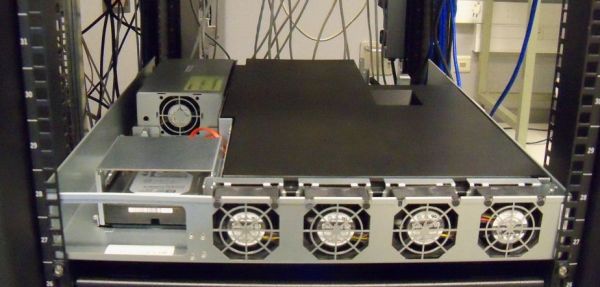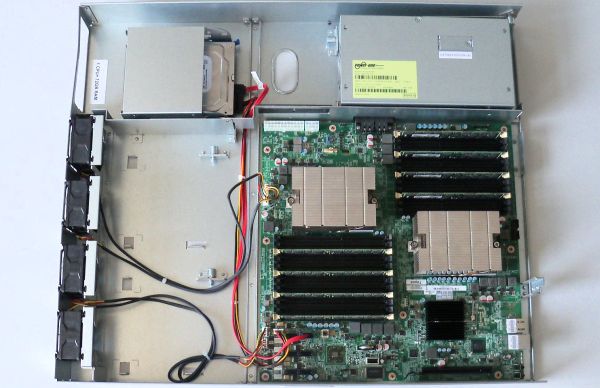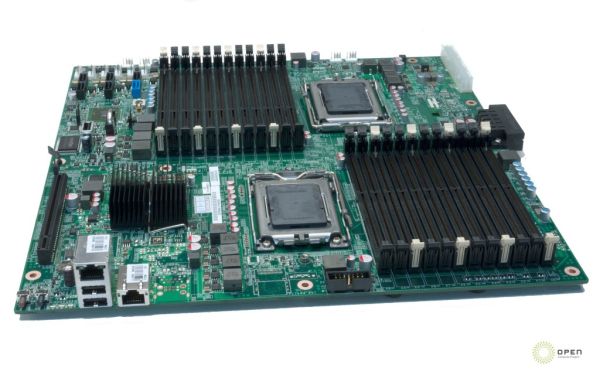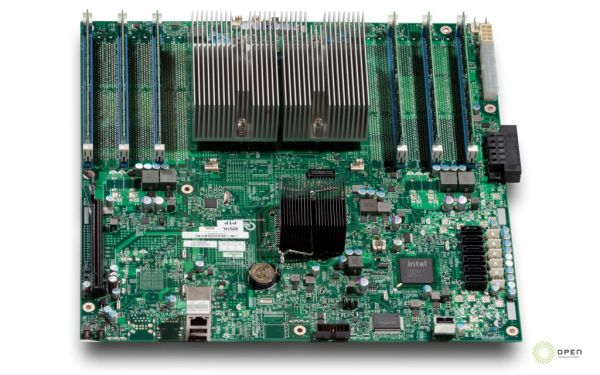Facebook's "Open Compute" Server tested
by Johan De Gelas on November 3, 2011 12:00 AM ESTThe Facebook Server
In the basement of the Palo Alto, California headquarters, three Facebook engineers built Facebook's custom-designed servers, power supplies, server racks, and battery backup systems. The Facebook server had to be much cheaper than the average server, as well as more power efficient.
The first change they made was the chassis height, going for a 1.5U high design as a compromise between density and making the server easier to cool. 1.5U allows them to use taller heatsinks, larger (60mm) lower-RPM fans than the screaming 40mm energy hoggers used in a 1U chassis. The result is that the fans consume only 2% to 4% of the total power, which is pretty amazing as we have seen 1U fans that can consume up to one third of the total system power. It seems that air-cooling in the Open Compute 1.5U server is as efficient as the best 3U servers.
At the same time, Facebook Engineering kept the chassis very simple, without any plastic. It makes the airflow through the server smoother and reduces weight. The bottom plate of one server serves as the top plate for the server beneath it.
Facebook has designed an AMD and an Intel motherboard, both manufactured by Quanta. Much attention was paid to the efficiency of the voltage regulators (94% efficiency). The other trick was again to remove anything that was not absolutely necessary. These motherboards have no BMC, very few USB (2) and NIC ports (2), one expansion slot, and are headless (no videochip).
The only thing that an administrator can do remotely is "reboot over LAN". The idea is that if that does not help, the problem is in 99% of cases severe enough that you have to send an administrator to the server anyway.
The AMD servers are mostly used as Memcached servers, as the four channels of AMD Magny-cours Opterons 6100 are capable of using 12 DIMMs per CPU, or 24 DIMMs in total. That works out to 384GB of caching memory.
In contrast the Facebook Open Compute Xeon servers only have six DIMM slots as they are used for processing intensive tasks such as the PHP "assembling" data servers.














67 Comments
View All Comments
jamdev12 - Thursday, November 3, 2011 - link
I would definitely have to agree with you on this notion. HP servers are pretty expensive when you take into account 3 year warranties and 24/7 replacement options that going with a open compute server is a nice alternative to the "I can do everything" server. Better to stick to something you can do pretty well and efficiently than I can do many things poorly.haplo602 - Friday, November 4, 2011 - link
this is an option for somebody with a custom built infrastructure and dedicated DC services. however a general purpose server CANNOT do without.since the server category is different (general purpose vs custom built) the HP one does well (I'd say even excelent).
HollyDOL - Thursday, November 3, 2011 - link
I would be quite interested how they determined Java and C# are 2/3x slower than C++. Since it seems pretty non-corresponding with reality to me. I have seen a few tests C++ vs. Java and the differences were in matter of %. As well as C# in my experience does the same jobs little bit faster than Java and the benchmark results generally confirm it.few links:
http://blog.cfelde.com/2010/06/c-vs-java-performan...
http://reverseblade.blogspot.com/2009/02/c-versus-...
setzer - Thursday, November 3, 2011 - link
I'm guessing they are comparing their algorithms and I hope they are good programmers for all the languages they tested otherwise the tests don't mean anything.Taft12 - Thursday, November 3, 2011 - link
I'm not surprised that part of the article would lead to programming language holy wars, but general benchmarks are utterly useless for Facebook. They should (and surely do) care only about performance of the compiled code and hardware platforms that run the site.bji - Thursday, November 3, 2011 - link
It's illogical to suggest that an interpreted language like Java or C# could ever approach C++ in speed when the same level of optimization is applied to each.In my experience, the least optimized C++ code can sometimes be approximated in performance by the best optimized Java code, depending on the task in question.
Of course, once you spend time optimizing the C++ code then there is no way for Java to keep up.
I have never used C# but I expect the result for it would be very similar to Java due to the similar mechanics of the language implementation.
That being said, in many situations raw speed is not the most important factor, and Java and C# can have significant advantages in terms of mechanism of deployment, programmer productivity, etc, that can make those languages very much the best choice in some situations; which is why they are, in fact, used in those situations in which their advantages are best exploited and their weaknesses are least important.
I think that Ruby takes the last paragraph even further; Ruby is so ungodly slow that it has to make up for it by allowing extreme productivity gains, and I expect that it must (I've never programmed in it to any significant extent), otherwise it wouldn't have any niche at all.
data003 - Thursday, November 3, 2011 - link
While I've lurked this site for many years I just created an account to correct this erroneous bit of fail above.1. C# and Java are not interpreted languages. The are compiled at runtime into machine code.
2. The C# JIT compiler can actually produce more efficient machine code than a compiled C++ binary.
Since you have never used C# and clearly don't understand how it works, I'd suggest you refrain from commenting on it.
Jaybus - Friday, November 4, 2011 - link
I agree that in some cases a JIT compiler can produce more efficient code, particularly when the application lends itself to runtime optimizations, however that is far from typical. Usually, for a single process, the JIT code, once compiled, will be reasonably close, though the static C/C++ code has the edge.But that is for the typical case. Facebook is not a typical case. Each web server is constantly starting many, many short-lived processes. Each process must start up its own copy of the code. This is where JIT fails badly to ahead-of-time compilation. It isn't the execution speed of the code after the JIT gets it compiled. The problem is the startup delay. Even with caching, the bytecode still must be compiled at least once for each new process, which in Facebook's case is millions of times. There is no such delay with ahead-of-time compilation. Therefore, Java and C# have no chance of competing in Facebook's environment.
erwinerwinerwin - Thursday, November 3, 2011 - link
i wonder whether power consumption justifies them to create a new hardware w/ green power architecture and the cost they spend to having a custom build power supply running on 270volt, if it's only saves about 10-20 percent average of power consumption, rather than lets say make a corporate deal to the best power/performance servers producer on the market and modified it with water cooling (for example)???Menetlaus - Thursday, November 3, 2011 - link
Power savings absolutely justifies the work they did in customizing.20W less power consumption x 24/7/365 operation = 175KW.h (per server per year)
175KW.h x $0.1/kw.h = $17.50 in power savings/year
Just looking at the final image in the article there are easily 30 racks of 30 servers visable (30 x 30 x 17.50 =) $15 750/year in power saving.
Since most power going into a computer ends up as wasted heat, if the 900 servers (from above) were consuming the additioanl 20W this would be ~18KW of additional heat being produced which needs to be cooled. This offers additional operational and capital cost savings due to the smaller cooling requirements.
Water cooling may be a more efficient way of pulling heat out of the server rack, but the additional parts to move the water around the facility and to cool it adds to the total costs. Water is more efficient because it carries more heat/volume than air and with the piping the heat can be taken outside of the server room, while fans heat the air around the servers where another method of removing the heat is then required.
The custom power supply at 270V and custom motherboard aren't really that difficult to get, as so many makers of each part already do custom designs for major PC makers (Dell/HP/etc). The difference between 208v and 270v from an electrical design standpoint isn't a big change, neither is removing parts from a motherboard.
In short it's the economy of scale. You or I wouldn't be able to do this for a dozen personal systems as the costs would be huge per system, on the other hand for anyone managing 1'000's of servers the 20W/per adds up quick.